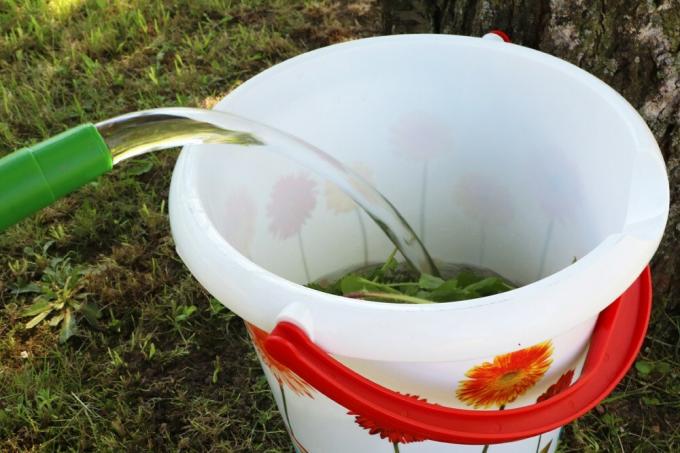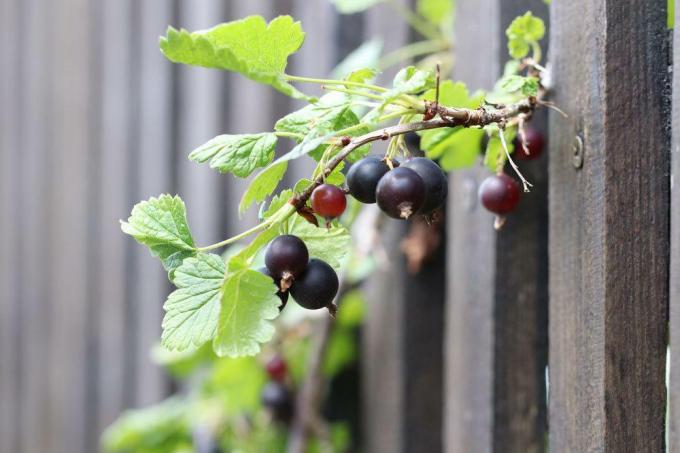
table of contents
- Fertilize currants
- The right fertilizer
- Correctly dose berry fertilizer
- time
- Natural fertilizers
- Nettle manure
- Horn meal or horn shavings
- compost
- Manure
- Don't forget to mulch
Both white, red and black currants (bot. Ribes rubrum or Ribes nigrum) have a very high nutritional requirement, as they have to constantly develop fresh shoots in order to develop numerous delicious berry fruits. Healthy, high-yielding shrubs at best add up to 50 centimeters of new growth per year, but this can only be achieved through optimal fertilization. Therefore, you should properly fertilize your currants from the time they are planted.
Fertilize currants
High nutritional needs
Currants have a high nutritional requirement, but this does not apply to all nutrients equally. A balanced fertilization provides the plants with nitrogen (N), phosphorus (P) and potassium (K), which are the main nutrients. In addition, plants also need other nourishing elements and micronutrients such as magnesium, zinc, calcium, etc.
Classic NPK fertilizer contains 16% nitrogen, 6% phosphorus and 12% potassium, with currants being used suitable, ready-made berry fertilizers from specialist shops typically 9% nitrogen, 3% phosphorus and 10% potassium contain. The berry bushes need above all nitrogen and potassium for strong shoot growth, while the phosphorus content should be kept rather low.
tip: A potassium deficiency in currants can be seen very quickly by the brown, upwardly curled edges of the leaves. Fertilize the affected bushes with Kalimagnesia (patent kali) or carefully work some wood ash into the root area. Also coffee grounds and Nettle manure Classic home remedies contain a lot of potassium.
The right fertilizer
Even if it is easy to get berry fertilizer from the garden center, there are a number of reasons why you should organic means give preference:
- effective over a longer period of time
- continuous and long-term supply of nutrients
- Activation of soil life by promoting micro-organisms
- environmentally friendly
- insect and animal friendly
- harmful ingredients do not get into the groundwater
- sustainable and resource-saving
- Over-fertilization is practically impossible
The most important difference is that mineral fertilizers work quickly, but also get out of the ground just as quickly can be washed out - for example, because the plant cannot absorb the nutrients on offer at once or is currently unable to raining heavily. Over-fertilization, which damages the plant as well as an undersupply of nutrients, is also possible through incorrect dosing and has serious consequences for the entire environment. For successful organic fertilization, however, it is important that you start long before budding.

tip: If you still prefer mineral fertilizers, it is best to send soil samples to a specialized institute (e.g. B. at the examination centers of the respective state chambers of agriculture). With the evaluation, you will also receive fertilization recommendations that are perfectly tailored to your garden soil and the plants growing on it.
Correctly dose berry fertilizer
If you want to fertilize your currants organically, you don't have to resort to compost or manure straight away. In addition to the classic fertilizers based on mineral ingredients, organic organic berry or universal fertilizers (pay attention to the composition!) Are also available in specialist shops. So that your Ribes bushes bloom profusely and produce numerous fruits, you should dose it as follows when using such a product:
- Before planting: mix 80 - 160 grams per square meter into the excavation
- Spring fertilization: apply 90-140 grams per plant annually in March
- Second annual fertilization: at the end of April / beginning of May, fertilize another 50 to 80 grams per plant
In late autumn, shortly before the hibernation, you should also have an approx. Spread a five-centimeter layer of mulch. This text explains in a section below which materials are particularly suitable for this. However, in locations with low pH, be sure to add algae lime to the mulch to increase it. Currants feel most comfortable at a pH of 7.
Note: Currants react to the often mineral or Substance chloride (Cl) added to ready-made fertilizers is very sensitive. It is therefore essential to ensure that you are buying a chloride-free agent when buying.
time
Because of the high nutritional needs, you need currants several timesin theyear fertilize, whereby certain times are to be observed. The fertilizers are to be applied in good time so that they can develop their effect. You should stick to the specified schedule, which also applies to all other types of fertilizer. It is important that from the time the fruit begins to develop, neither natural nor organic Means are administered, as this has a negative impact on the harvest quantity as well as the taste of the berries Has. Over-fertilized plants in this way tend to sprout so that they neglect fruit formation.
Natural fertilizers
Natural fertilizers such as compost, stable manure (especially horse manure) and horn shavings or shavings are perfect for providing the right nutrients. -flour as well as tried and tested home remedies such as home-made ones Herbal manure. However, the following pointers are important when using these agents:
- no concrete information on ingredients in compost and manure possible
- Ingredients vary greatly depending on the composition. B. of the compost heap
- therefore hardly any concrete dosage information is possible
- Rule of thumb: four liters of compost or manure per square meter
- smaller / younger bushes less, older / bigger ones more
- nitrogen-based agents (horn meal, horn shavings) are unsuitable as the sole fertilizer
The nutrient supply with natural fertilizers works best when you combine different agents with one another. Garden compost and rotting manure, for example, are an ideal addition to nitrogen-rich horn or bone meal (and other horn products). Plant manure also provides the currants with all the necessary nutrients over the growing season, but should also be supplemented with basic fertilization (compost / manure).
Nettle manure
Currants can be supplied with plant manure throughout the summer, especially with these agents Also effective as a classic home remedy to fortify plants against fungi and other pathogens are. Nettles are particularly suitable:
- Roughly chop one kilogram of fresh nettle leaves and stems
- fill in a large vat or bucket
- do not use a metal container
- fill up with ten liters of water
- add two handfuls of primary rock flour
- stir vigorously
- cover carefully
- set up in a dark, warm place
- Let ferment for two to four weeks
- stir daily
As soon as the mixture stops foaming, the nettle manure is ready. Now dilute it 1:10 with fresh water and pour it over the currant bushes. Apply the product directly to the ground and in no case through the leaves.

Horn meal or horn shavings
It is best to administer horn shavings or meal together with garden compost or manure when fertilizing for the first time in spring or when mulching in autumn. This agent takes a long time to decompose - so the nutrients it contains are only released late.
compost
Well-ripened garden compost is the ideal fertilizer not only for Ribes. Fertilize the currants twice a year with approx. two to five liters of compost per square meter of planting area, the amount used depending on the size of the shrub.
Manure
If, on the other hand, you decide to fertilize with stable manure, give preference to dried horse or chicken manure. The dosage is the same as for garden compost.
tip: In principle, dried coffee grounds can also be used to fertilize the currants, however Firstly, it is not suitable as the sole fertilizer and, secondly, it acidifies the Soil. Accordingly, you should mix coffee grounds with algae lime to keep the pH value constant.
Don't forget to mulch
Since currants develop flat roots that run close to the ground, you should regularly apply a mulch layer about five centimeters thick in late autumn. This keeps the earth moist because it reduces the degree of evaporation. Mulching also suppresses the development of weeds, which in turn would compete with the currant bushes for nutrients and water. Furthermore, rotting mulch provides additional nutrients and fresh humus.
The following are particularly suitable as mulching materials:
- Chopped straw
- coarse compost
- Foliage (except walnut or oak leaves)
- dried-on lawn or Clippings
However, it is unsuitable Bark mulch, as this removes nitrogen from the soil and also often causes acidification. If you still want to use bark mulch, fertilize with horn shavings / horn meal and algae lime before spreading.




